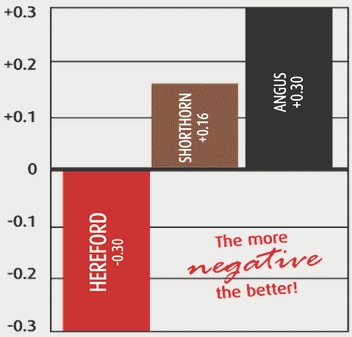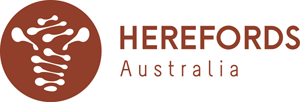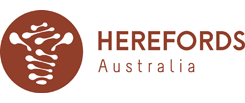The Herefords Advantage
Breeding
This section will give an understanding of the basics behind a successful breeding program.
PROFITABILITY – PERFORMANCE & PROFIT
What is Temperament?
Temperament is also referred to as docility. It relates to how an animal reacts to stress.
Why Care about it?
Temperament can increase production costs and injury risks or it can improve productivity, performance and manageability.
Why select for it?
Herefords are docile, efficient and productive. The breed’s temperament will impact positively on your herd’s:
- growth rates
- carcase quality
- Stress levels
- fertility
- ease of handling
More money in your pocket
Cattle with slow flight times, ie good temperament:
- grow faster to final weights
- have heavier carcases
- have better feed conversion ratios
Beef CRC results show “A conservative difference of $80 to $100 per head by selecting good feedlot performers based on temperament”. Over 78 days, nervous group steers grew at 1.04kg/day, while calm steers grew at 1.46kg/day.
Beef CRC Flight Time Factsheet
The Advantage of British Breeds
British breeds (Bos taurus) have production characteristics which differentiate them from European (Bos taurus) and Brahman (Bos indicus) genotypes, and which confer a competitive advantage to them when used in either purebreeding or crossbreeding production system, particularly in temperate environments.
Primary (cow-calf) selection regimes for British breeds have traditionally been pasture based which has resulted in selection of animals reflecting high efficiency of feed conversion, high fertility, docility, moderate size and medium physiological maturity – prerequisites for easy finishing ability and highly acceptable meat quality.
Recent selection regimes in some countries has focused selection on an extended growth curve, performance under feedlot conditions and improved carcase performance.
The blending of traditional and recent selection regimes now provides a genotype with a wide range of within breed/genotype variation for all major production traits. British breeds are uniquely positioned to target pure or crossbreeding systems, for light through to heavy weight carcases finished on either pasture of grain. No other genotype has this range of abilities.
This advantage is becoming more significant as markets move towards value based marketing and the end consumer is having a greater influence in determining the outcome of breeding programs.
Preliminary results from Australia’s Cooperative Research Centre (CRC) in Meat Quality clearly demonstrate significant consumer benefit from British breeds.
Using a composite scoring system (MQ4 score) that included tenderness, juiciness, flavour and overall eating quality acceptability; peak force and marbling (IMF%), British breed sired calves ranked higher than European, Brahman or Brahman derived sire breeds.
- Genotype MQ4 score peak force (kg) IMF(%)
- British breed 59 4.49 4.00
- European 53 4.95 2.50
- Brahman 41 5.60 2.57
- Brahman derived 50 5.15 2.90
Australian Herefords have contributed significantly to the above results and have demonstrated superiority in terms of yearling growth, and yield to their Angus and Shorthorn counterparts. Early results from the Cooperative Research Centre in Meat Quality at Armidale also demonstrate superior net feed conversion efficiency in favour of the Hereford.
EFFICIENCY – ECONOMIC BEEF PRODUCTION
Feeding cattle is the single, largest variable expense in commercial beef production. Profitability depends on costs and revenue.
Hereford cattle can decrease feed requirements and improve feed utilisation to reshape profitability and sustainability for farmers.
What does it mean for the producer?
Whiteface Cattle Consume Less Feed – Their daily feed intake is 1.2kg/day less than Angus cattle.
Whiteface Cattle Maintain Growth & Gain – They consume 6% less feed for the same gain as Angus cattle.
Whiteface Cattle Can Boost Your Herd Size – You run 106 Poll Herefords on the same ground and feed supply as 100 Angus cattle
Whiteface Cattle Save You $$$$ And Time – Less feed, means less inputs, means less cost. It takes an extra 61 tonnes of feed annually for a 100-cow Angus herd compared to a 100-cow Hereford herd.
Science has proven it
Practical farmers have always known that Herefords have the genetic potential to improve a herd’s feed intake and feed utilisation. Now science has proven it.
Latest industry research, reveals that Hereford is the number one British breed when it comes to net feed intake (NFI).

Conducted by the Cooperative Research Centre for Cattle and Beef Quality (Beef CRC), with collected data analysed by the Animal Genetics and Breeding Unit (AGBU) at the University of New England, Armidale, the research reveals Herefords are ahead of their Angus and Shorthorn competitors with significantly lower NFI.
Simply, Hereford-sired progeny consumed significantly less feed daily, without sacrificing growth and gain.
BEEF CRC Research – Sire Breed Differences for Net Feed Intake

